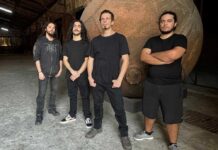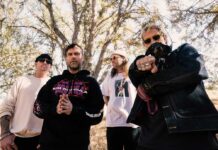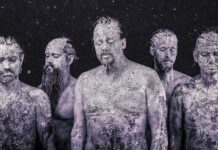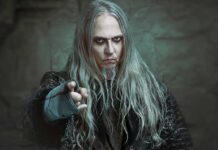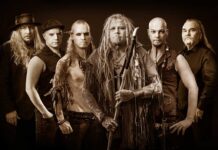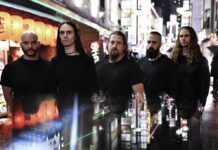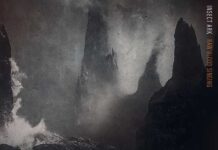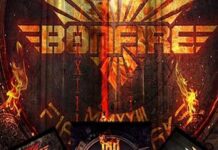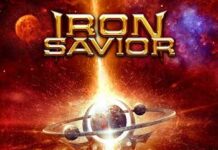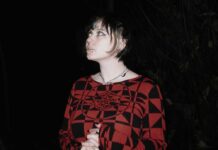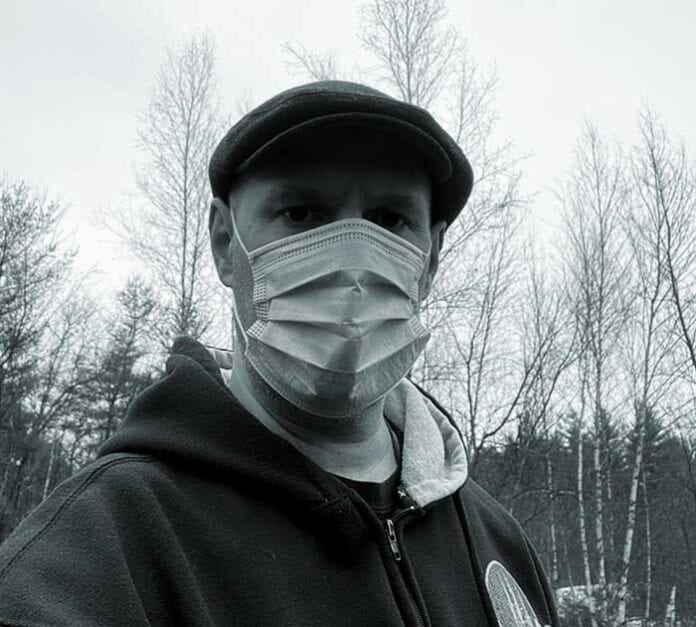
INTERVIEW WITH TED TRINGO BY GEORGE PACHECO
It isn’t every day you get to stroll down memory lane. Dark Symphonies was a label dedicated to the dark and macabre but not limited in scope. This also applied to Autumn Tears, a musical expression of Ted Tringo’s darkwave and neo-classical influence that brought together talented voices and musicians from across the board.
Actually, we shouldn’t speak in the past tense, because both Dark Symphonies and Autumn Tears are going strong, with the latter releasing The Glow of Desperation in 2021 like they didn’t miss a beat. Between this welcomed return and Dark Symphonies outstanding reissue game with their sub-label The Crypt, Tringo certainly has his hands full. However, he did take the time to reconnect after many years to recall both the good old days and the bright (or is that dark?) future ahead for Autumn Tears.
It’s been a long time, how the hell are you? It’s good to be here with you again, as the two of us go way back. Would you mind enlightening us what forming Autumn Tears was like during a time when yourself and Dark Symphonies was just getting off the ground?Autumn Tears began in 1996 and was in fact the first release on my label Dark Symphonies, which had only been a mail order up until then. I had always loved metal and wanted to start distributing it to help share my love for the music with likeminded people. Although Autumn Tears is not even close to metal, I feel some of the themes and emotions that I was expressing back then could be considered to have bled into the metal genre. I was inspired by soundtracks, classical music, and darkwave bands of the time. I wanted to create something somewhat different as a way to express my creative side without doing something that had already been done many times before. Fortunately, the metal scene was very receptive of our first album and helped us to get a small foothold in the metal community.
“I HAD ALWAYS WANTED AUTUMN TEARS TO EVOLVE INTO SOMETHING RICHER AND MORE MATURE SOUNDING WITH LIVE CLASSICAL MUSICIANS”
The band was on a regular schedule of releases during the late 90s. What prompted this early burst of creativity, and why did the band take a hiatus from The Hallowing in 2007 to The Origin of Sleep in 2018?
Back then it felt like I had a lot more time to write, and I had the theme all planned out for those earlier albums. They had a certain structure that made it easier to follow, but also the writing style of the earlier material was much simpler and basic, which made it easier to finish. As the years passed, I had always wanted Autumn Tears to evolve into something richer and more mature sounding with live classical musicians, but back in the 90s it wasn’t really feasible. Also like in many bands, there were creative and personal differences that caused friction, so after The Hallowing, I decided to go dormant. During those 11 years I studied music and composition, so if and when I ever resurrected the project, I could present it the way I always felt it should sound. In 2018 when we released our comeback EP The Origin of Sleep, the music had matured into a much more classical style, utilizing actual live classical musicians this time. Now it is much easier and more fulfilling to continue writing in the way where I compose everything and then hire session musicians to play and record all the parts. There are a few musicians and vocalists that make up the core of the project, but aside from them, I have endless possibilities to how many musicians I bring into the fold.
Dark Symphonies was conceived initially as an outlet for your own projects. Did you ever think that work for the label would expand the way it has, creating awesome sub-labels like The Crypt and being a vital force for reissuing classic extreme metal titles?
It’s funny because around 2007 when I stopped writing music, the label itself took a short two year hiatus as well. It was getting to be too much stress working with so many bands and trying to juggle that and the mail order as well. Too many wheels going at once, so I needed a breather. I phased out the mail order and label and took time regroup. Then in 2008, I started seeing vinyl reissues of classic releases in the stores and to put it gently, they were quite subpar, with blurry artwork and poor sound. I decided right then and there that these classic bands that I came up with deserved a much higher standard for their amazing albums. I got in touch with Hempa from Excruciate and hence, The Crypt was born. I contacted Kristian Wåhlin who painted the original cover so I could have the best possible source for the artwork. If you are going to do something, do it right I feel. In most cases we are able to secure the original DAT tapes for the best sound, or even the original analog mix tapes in some cases. In 2014, we decided to expand the same principle to CDs as well as vinyl. It’s been a very fulfilling journey ever since.
The visual aspect of Autumn Tears has always been a priority. How much goes into the conception of a new release in regards to the visuals with the music?
First and foremost, I have always been an illustrator since I was old enough to hold a pencil. Visual presentation has always been very important to me, as it is the first thing you see to draw you into a book or an album. I am also a graphic designer, so I understand how important it is to make sure the visuals are very eye catching as well as representing the music. I always find the best suited pieces of artwork that reflect my vision, and if I have something very specific in mind, then I will commission the piece so it reflects exactly what I want, for example, the cover for The Origin of Sleep. That was a custom illustration that was based on my own concept and ended up coming out exactly as I had envisioned. There are so many great artists out there, and I am always looking for new illustrations to represent my upcoming projects.
“I HAVE HAD WHAT SEEMS LIKE AN ENDLESS STREAM OF CREATIVITY AND INSPIRATION, MORE SO THAN I EVEN HAD IN THE PAST”
The Glow of Desperation is your latest album in what has been another string of inspiration. What do you attribute the new burst of creativity to?
I am very thankful to say that as of 2018 when Autumn Tears was reborn so to speak, I have had what seems like an endless stream of creativity and inspiration, more so than I even had in the past. I think a lot of it has to do with being in my 50s now and seeing life in a way that I could never understand when I was in my 20s. I have a better appreciation for what is important, and that makes it much easier to free my mind to write music. It has been pretty much a non-stop roller coaster of musical ideas over the last few years, and I don’t ever plan on stopping the project again!
Has the creative process for Autumn Tears changed over time?
In the early days it was a bit easier mainly because my music skills were still developing and I hadn’t really studied music as much back then, so the melodies were much more simple and repetitive, making the writing process a little easier. As time went on, I began incorporating more music composition and branching out my musical tastes so I would have a larger creative pool to work from. Now when I write, I can usually hear the song playing out in my head, which seems to be happening much more than it did in those days, so all I need to do then is write it down and refine it before moving onto the next piece.

The female voice plays such a vital role within the music of Autumn Tears. How has it been working with so many talented singers over the course of the band’s existence, and particularly with this album?
When the project first began, it consisted mainly of keyboard music and female vocals. I always loved how that sound came together, and it was something I wanted to try and take to a new level. I had also done some singing on the earlier releases, but decided to focus instead on composing, which is why I have not done any vocals since 2004. After the 2018 revival, I wanted to continue the same idea but expand it as much as possible. Agnete and Ann-Mari from Madder Mortem and ex-The Third and the Mortal respectively was a dream come true for me, especially with them singing a duet together. I was completely humbled, as they are two of my favorite vocalists from the early days, so I am still swooning from that. In addition to many others, Brona McVittie and her elegant, earthy tone who started with us in 2018 to get the ball rolling again, to Caroline Clarke [Trovatori], our soprano supreme who is as talented a composer as a singer, to Anne Anaé Lauren, a brilliant singer with a wide range from classical to world music, to Tamar Singer [Zeresh, Cruel Wonders], who’s amazingly unique vocal style and sound, all of these amazing vocalists helped to add more diverse levels of sound to our evolution.
“Knowing All Has Been Decided,” “For Only a Day,” and “Reunion” very much capture that nature of melancholy and desperation. There seems to be a very deliberate grasp on melody, and the hooks and songwriting burrow deep upon multiple listens.
Thank you so much! “Knowing All Has Been Decided” was the first track I wrote for Ann-Mari. I wanted to capture the Autumn Tears sound, but didn’t want the track to remind anyone of the old 3rd and the Mortal sound, as I wanted to create something new and unique with her that still had all the emotions and feeling that we strive for. “For Only a Day” I feel has a more traditional Autumn Tears sound, whereas I used more of the writing style on the previous album, but still wanted to have it be unique in its own way. “Reunion” is probably my favorite Autumn Tears track to date. The deep emotion that Tamar summoned for that song makes me literally go numb when I listen to it. Supported by backing vocals from Agnete, that track captures what is the epitome of Autumn Tears. We even designed a t-shirt just for that song.
“MY GOAL WAS ALWAYS TO HAVE THE MUSIC BE JUST AS IMPORTANT AS THE VOCALS, WHERE THE EMOTION AND MOOD COULD BE HEARD EVEN WITHOUT ANY LYRICS.”
This new Autumn Tears album stands as a very active listen, one that rewards the listener for paying attention. Was that ever deliberate, to progress beyond traditional parameters of what dark ambient music is or is supposed to be?
It was definitely always deliberate, as my goal was always to have the music be just as important as the vocals, where the emotion and mood could be heard even without any lyrics. This was intentional in the writing, as it is important for every part of the song to be equally interesting and enjoyable. This way when the vocals are laid down, the song can come alive and make you really feel it as a whole. I have even written a few instrumental tracks on the last few releases [“Breathing Beneath the Soil” and “Drift”], as sometimes once the music is done, depending on the song, it is complete and adding vocals wouldn’t be necessary at that point. There is nothing wrong with ambient music, in fact, I enjoy a lot of it. It’s just not something I wanted for Autumn Tears.
Labels like Cold Meat Industries were formative when first exploring darker sounds like this, outside the realm of metal. Was your journey similar, and what exposed you to the world of darkwave and neo-classical?
In fact, yes, I got the Cold Meat sampler with Arcana’s “The Song of Mourning,” which I heard when I was in the middle of writing our first album and I was blown away. I also discovered Stoa and Anchorage then as well. All three bands were/are amazing and definitely helped to influence me in my early years. All these years later, Peter from Arcana and I are friends. He actually mastered our 2018 EP The Origin of Sleep. Olaf from Stoa and I have also become friends. He mastered our 2019 album Colors Hidden Within the Gray. It’s definitely a small world, and I am very honored to have been able to get to know people whose music I fell in love with back then.
Autumn Tears resists the urge to incorporate metal into your sound. Was this ever a conscious decision, even though you’re obviously a metal fan?
Ever since day one, I decided I did not want to ever incorporate metal into our sound. There are many great symphonic metal bands, but I didn’t want to get lost in the shuffle, and more importantly, I was very happy with the sound we were developing and didn’t want to stray from our vision, which I still feel does have some unique qualities to it, even though there are other projects that have had a similar style.
“AUTUMN TEARS IS AND ALWAYS WILL BE A STUDIO PROJECT ONLY. THERE ARE TOO MANY FACTORS THAT MAKE IT IMPOSSIBLE TO PLAY LIVE”
Performance-wise, is there ever going to be a time when the talent assembled here for The Glow of Desperation could be brought together live?
Unfortunately, Autumn Tears is and always will be a studio project only. There are too many factors that make it impossible to play live, most importantly, the fact that all the players live in various parts of the world. You figure anywhere from 20 to 40 musicians all in different time zones with all of their own lives to manage would make playing a live show unrealistic. That’s why I consider this a musical project as opposed to a band.
How about the actual studio time for this record? What went into the production?
As you can imagine the studio time involved was countless hours and took over a year to record. Praise to the power of the internet where the performers can record all of their parts remotely, send it to me, and I mix everything in my studio once I have everything. It’s very tedious, but the end result is always very fulfilling. You can’t really put a price tag on something you love to do.




